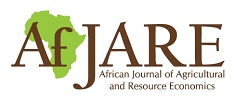African Journal of Agricultural and Resource Economics
(AfJARE)
Journal Africain d’Économie Agricole et des Ressources
(JAEAR)
Published by the African Association of Agricultural
Economists (AAAE)
ISSN 1993-3738
Volume 15, No. 3 (September 2020)
Smallholder farmers face considerable risk and uncertainty, particularly when markets are incomplete or missing. We consider household crop diversity and crop choice in Zimbabwe, where output markets are largely absent and price signals are inaccurate.
Déterminants d’insolvabilité des termes de contrats agricoles : cas des riziculteurs du Burkina Faso
La production du riz sous contrat a pour avantage de répondre aux exigences de la qualité de la production du riz et de satisfaire la demande intérieure du riz pour le pays. Cette étude a pour objectif d’analyser les critères d’insolvabilité des contrats des riziculteurs au Burkina Faso.
Nutrition knowledge is an important driver of household dietary diversity that can be improved through access to nutrition information. However, in many rural areas, the formal flow of nutrition information is limited, although social networks could play an important role as an informal source of such information.
Despite the crucial role played by Nile perch in the income of fishers around Lake Victoria, Tanzania, fishing pressure has increased in recent years and has led to overfishing and, consequently, a risk to the lake’s future sustainability and the fishers’ livelihoods. This study used data collected in 2018 from 268 randomly selected sample fishers at 10 landing sites across Lake Victoria.
Baobab products provide cash income and supplement diets for local communities living in marginalised, arid and semi-arid regions. However, these products are neglected by research, selectively traded and considered underutilised. This study endeavours to narrow this information gap by analysing the determinants of baobab collectors’ choice of marketing channels in Kenya.
Mali’s population is experiencing lifestyle and dietary changes that are driven in part by urbanisation and income growth. Utilising two large-scale datasets, we bring new empirical evidence regarding whether Malians are shifting toward highly processed foods, meals purchased away from home, and sugary foods.
